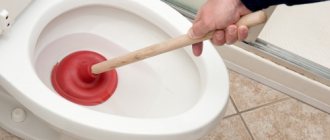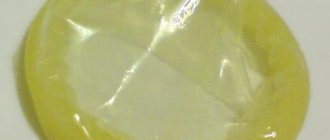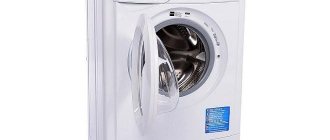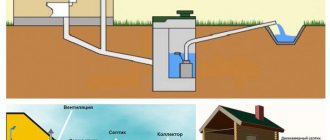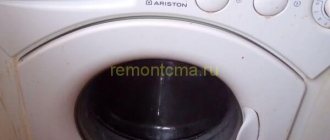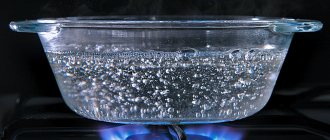Causes of toilet breakdowns
- The sewer pipe becomes clogged and stops flowing wastewater.
- There is no pressure when flushing. This occurs when the drain channels become clogged.
- There is not enough water in the tank. The problem may be due to a broken float.
- The bowl itself has become worn and rough.
- The sewer pipe has a poor slope or small diameter.
- No fan boner. This mainly applies to private houses. The air lock prevents water from passing through.
- Incorrect installation.
Why does the sewer freeze?
Reasons for freezing sewer pipes:
incorrect design of the angle of inclination of the sewer pipeline. Water is not able to move by gravity and stagnates in the pipes, which leads to freezing in the winter;
insufficient burial depth. According to SNiP, the septic tank is installed at a depth of at least 2 meters from the soil level, the pipe system is located below the freezing point characteristic of the region. But a situation is possible when you are simply too lazy to dig a trench for laying pipes deep (or there is no possibility) or frosts exceed the average and the soil freezes deeper;
lack of insulation. Sewage pipes laid above the freezing point of the soil require insulation. The place where pipes exit the room must also be insulated. However, in practice, such a requirement is either ignored, or an unsuitable thermal insulation material is used, or its installation is carried out incorrectly;
small pipe diameter. If we consider consumer reviews, then most often those who have laid pipes with a diameter less than the recommended 110 mm are faced with the problem of sewerage freezing. Owners of summer cottages and houses that are used seasonally are especially often guilty of this. Due to insufficient diameter, the sewer pipe freezes faster;
blockages. They happen due to large objects getting into the system or insufficient water flow, which causes plaque to form in the pipes.
Causes of septic tank freezing:
The drainage from the septic tank is broken. In this case, the septic tank overflows, heavy fractions settle, and the water freezes;
the septic tank is removed from the source of wastewater. Then the water, moving to the waste pit, cools, which leads to its freezing at the junction of the pipe and the septic tank.
Many users who do the work themselves do not even think about whether the sewer system is freezing. After all, the very principle of operation of a septic tank is that it is a container for storing wastewater with actively occurring decomposition processes. Since heat is released during the decomposition of solid residues, freezing is practically excluded. In addition, according to standards, the septic tank is installed at a considerable depth.
However, no one is insured against force majeure, and it is better for the owner of a country house to know in advance what to do if the sewage system is frozen.
Ways to clean a toilet
Chemical. It is better to first pour boiling water from the kettle into the toilet.
- But it is forbidden to immediately fill the toilet with boiling water. First, pour hot water, and only then boiling water.
- After all, the plumbing may fail and crack if you immediately pour boiling water into the toilet bowl.
- If hot water does not help in combating the blockage, then chemicals are used.
There are many different chemicals in the store. The most popular among the population is “Mole”.
Mechanical
If boiling water and chemicals do not help, then use a plunger.
- It is placed in a bowl and pressure is created with quick movements.
- They also use a plumbing cable.
- The tip of this cable moves along the sewer pipe and grabs or breaks the clog.
After cleaning the pipe, you need to rinse the toilet itself with water.
What to do
If you believe the clog is in the trap or outlet, you can try using a plunger or plumbing cable to remove it.
plunger
For use in a toilet, you need a plunger of a larger diameter than for sinks, since the cross-section of the pipe is much wider. If you don’t have a plunger and are just planning to buy one, you can choose a model with replaceable nozzles or an automatic device, where the pneumatic shock is created not with the help of your force, but mechanically.
How to use a classic plunger:
- Place the plunger against the toilet drain hole and make sure that it fits snugly against the surface; the device should create a vacuum inside the pipe.
- Make several back-and-forth movements.
- Pull the plunger towards you.
- Repeat.
Ideally, after the first flush in the toilet water, you will see pieces of dirt that have clogged the drain. They need to be pulled out with gloved hands and thrown into a pre-prepared garbage bag.
Plumbing cable
The plumbing cable is suitable for cleaning any sewer pipes in the house, including toilets.
- Unwind the cable completely.
- Start immersing it in the water and carefully push it inside the pipe, changing direction.
- Once you have pushed the cable deep enough, slowly pull it out.
- Remove any dirt remaining on it and throw it into a pre-prepared trash bag.
These steps must be repeated 3–5 times until the cable begins to come out clean, without large pieces of dirt.
After using the plunger and/or cable, drain the water to check its current and, if everything is in order, use a special pipe cleaner, such as:
- Domestos for blockages
- Sanfor
- Mole
- Tiret
- Deboucher
They will help dissolve and remove remaining contaminants on the pipe walls.
Due to the large diameter of the pipes, cables with a brush at the end are well suited for toilets.
Not enough water when flushing the toilet
Fixing this problem depends on what mechanism the toilet has. Mostly tanks with a float mechanism. Here the float is responsible for the volume of water. There may be some breakdowns in its operation that prevent it from being washed off.
- Water can get inside the float and it sinks into more water than necessary.
- The problem can be corrected by gluing the hole in the float and removing the water from it.
- If it cannot be repaired, you can replace it with a new one.
The problem may also be in the inlet valve, which is responsible for filling with water. Need to check that too.
Solutions
Once the cause of poor flushing has been identified, it’s time to begin correcting the situation. By the way, sometimes even damaged enamel leads to worse flushing. Therefore, if in doubt, it is worth examining its integrity. Scratches, cracks and chips can trap water and waste, preventing it from flowing down the drain. This problem is relevant for all ceramic plumbing fixtures.
In this case, it would be better to completely replace the toilet. But even if this is not possible, the situation can be resolved. To carry out repair work, you should take ceramic putty or waterproof sealant, powder paint and a gun for applying it. Further actions are as follows.
- Clean and degrease the inside of the bowl. You should first turn off the water and dry the entire toilet, including the tank.
- Use fine-grained sanding paper to clean any chips or other damage.
- Apply putty or sealant to the desired areas.
- Dry the surface . Paint it white.
- Do not use the toilet for its intended purpose until all materials are completely dry. Usually this is 48-72 hours. You should find out the exact information in the instructions or on the packaging.
Such repair work will only temporarily eliminate the problem. However, this may be enough to look for a new toilet. If the appearance of the bowl is completely normal and there is no damage, then the problem lies in the sewer or drainage system. The solution won't take long.
The drain is clogged
This is a fairly common reason for poor toilet drainage. To solve this problem, you should use the following instructions.
- Look under the pear. Perhaps the debris has accumulated there and can be easily removed.
- If the blockage is visible, but it is impossible to pull it out by hand, then turn off the water supply and take tweezers with a flashlight. There is a chance that you can get a foreign object without disassembling the toilet. It is worth noting that the blockage under the pear is the most common and can be easily eliminated.
- If the problem is not visible in the tank or you still can’t get it out, then you will have to disassemble the toilet . To do this, unscrew the bolts between the tank and the shelf and remove the upper part. Remove debris or clean it if there is plaque involved. Assemble the toilet.
In some models, the tank has a separate shelf. Then it makes sense to unscrew the fastenings between it and the bowl. This will give you maximum access to the flushing system. It is worth noting that with this option you will have to replace the cuff under the shelf with a new one. During operation, it becomes less elastic and simply breaks during disassembly.
The toilet cistern drain is clogged
| Circumstance |
|
| Solution |
|
Tip: a closed lid of the flush container reduces the amount of evaporation in the toilet and does not make the air space in it more damp; moreover, it is also an aesthetic component of the room.
The volume of the tank does not increase
Fixing a tank leak can be difficult, especially if the problem lies in the design itself. But some actions can still be taken.
- If the bulb seat is clogged and it does not completely block the flow of water, then it is enough to clean it. After simple manipulations everything will return to normal.
- It happens that the pear loses its elasticity or breaks during use. In this case, you need to buy a new one and replace it. Such a thing is inexpensive, and replacing it will not cause difficulties.
- If the steel or plastic bolts inside the tank itself are broken, then water will penetrate into the shelf through the resulting gaps. Here you will have to decide according to the situation. Sometimes you can find and replace the bolts.
In particularly unfortunate cases, it is necessary to dismantle the entire set of fittings.
Water does not enter the tank
Here, too, you will have to start from the nature of the problem. If the blockage is due to plaque, then you just need to clean the valve. This is achieved by the following steps.
- Turn off the water only to the toilet tank.
- Take out the hairpin. It serves as a lock for the float lever in the valve.
- Clean the nozzle with a small flexible wire. You can also use a knitting needle, but the process will take longer.
- As a result, the part should be completely clean.
- Open the tank valve for literally 1 second. This way the water will remove the remaining small debris.
- Assemble the valve, turn on the water and check the quality of the drain.
If debris gets into the drain, you will have to spend a little more time. Experts recommend using the instructions described below.
- Shut off the water to the entire apartment.
- Unscrew the flexible hose connected to the tank.
- Remove the valve that shuts off the water supply to the tank. If there is a ball option that blocks the water by turning the flag, then everything is simple. It is enough to open it to the maximum to dismantle it.
- Now you have to make a device for cleaning pipes. Steel string for curtains is an ideal option. On one side you need to make a hook, on the other - something like a handle. With the help of the resulting tool, you can comfortably grab and pull out debris.
- It happens that the string simply passes by the supposed blockage. You should place something under the drain valve and turn on the water supply for literally 1 second. Most likely, it will gush and stop immediately. In this case, you need to continue to move the string at the site of the blockage. The water will flow and force out the debris.
It is worth paying attention that pipes made of metal-plastic and polymer do not become clogged. With such a sewer system, this is definitely not the reason for poor flushing. If a blockage does occur, then it is definitely within the toilet in the apartment. Pipes like these make life much easier.
Water does not fill into the tank
The cause of this problem may be that the float valve is clogged. The water may flow in a small trickle. To eliminate the cause, the tap is cleaned with a thin wire. Sometimes water is supplied. This is necessary to remove plaque that was removed during the cleaning process.
- The float valve can be adjusted.
- The water supply line may also be clogged.
- This mainly happens with steel pipes.
- There are no such problems with plastic ones.
- You can replace the pipes to prevent this problem from happening again.
Frequently asked questions
Since the design of all toilets is almost the same (the differences are unimportant and in our case may not be taken into account), some points can be addressed immediately, before unsolvable issues arise during the troubleshooting process.
Most problems arise due to the same reasons, so advice is always very useful.
What is better, trying to fix the problem or replacing the toilet right away?
The choice depends on the age and condition of the plumbing. If the toilet is old and uncomfortable, it is better to replace it. At the same time, it is necessary to take into account the specifics of the problems - sometimes replacing the device does not solve the problem.
Does it make sense to replace both the toilet and the tank at once?
We need to find out which node is the source of the problem. If the condition and performance of the second node are quite satisfactory, it is not necessary to change them.
What should be done if the toilet flushes, but ineffectively - you often have to repeat the procedure 2-3 times?
The easiest way is to increase the volume of drained water. You can adjust the reservoir (newer models have several options for adjusting the valve). If the problem cannot be solved, you need to purchase a larger capacity tank.
What is the best way to unclog a clogged toilet?
It has already been said that it is more correct to act mechanically - to use a cable. The most effective method is hydrodynamic cleaning, which can be done using a Karcher car wash or similar.
If it is not possible to change the system configuration, how else can you eliminate the air lock?
Sometimes the problem is successfully solved with the help of an air valve, which is installed on a horizontal section of the sewer pipe. It balances the pressure in different parts of the system, allowing the air lock to be released freely. However, some models of such valves release foul-smelling sewer gases into the room, which is unacceptable in apartments.
It is important to keep in mind that eliminating one problem does not always give the expected result. Often problems occur in pairs or in larger numbers. Therefore, if the result turns out to be unsatisfactory, you should not despair, but look for additional causes of the problems. In any case, eliminating the causes automatically solves the problem, you just need to take all the necessary measures.
Tank leakage problem
This can be noticed when inspecting the water level in the tank.
- To eliminate this problem, the rubber from which the valve is made is checked. It may no longer be elastic. The problem is solved by replacing the valve.
- It is necessary to check whether this valve fits tightly to the seat. Due to various deposits, it may not fit properly.
- The drain mechanism rod may break. It can either be changed or repaired if possible.
- The siphon may be damaged. This requires replacement.
The most efficient drainage systems
Those who are just about to purchase a toilet should think about choosing the type of flush. The most powerful pressure is provided by designs with a high tank, that is, located almost under the ceiling. But due to their unpresentable appearance and loud noise, they are not used in apartments today - only in public toilets.
The currently popular “Compacts” use two types of drainage:
Water from the tank first rushes into the surrounding channel under the rim, then from there it pours into the bowl, so that the whole of it is washed evenly. Such a system is positioned as more effective, but this is a controversial issue. On the one hand, splashes are removed from the entire surface of the bowl and it actually becomes cleaner. But on the other hand, the flow intensity on the rear wall, which is most susceptible to contamination, decreases. The shower drain has one more drawback: if the water quality is low, the channel under the rim quickly becomes clogged with sediment;
soul-shaped (circular).- cascade _ All the water is discharged along the back wall, so that the side and front walls are almost not washed.
Much depends on the shape of the bowl. In visor and funnel-shaped ones, impurities are washed off well, in dish-shaped ones - not always. Therefore, the latter have lost popularity and are found today mainly only in hospitals.
The enamel has worn off
Toilets are almost always covered with enamel. Over time it wears off. And, if you accidentally damage it, then it will have scratches, damage, and so on. Smooth enamel becomes rough. And this is what prevents the toilet from flushing.
You can solve this problem by purchasing a new toilet. But not everyone can afford this method. You can try to restore it.
What's happened
Any most reliable household equipment becomes unusable over time.
This also applies to the toilet, which in this case begins to not flush well. We have to deal with this problem in more detail, find out the circumstances of its origin, and find methods for solving this problem. We will carry out all work ourselves without the involvement of expert plumbers. The following scenario is seen much more often - the toilet worked well and no troubles were noticed in its functioning. But suddenly the flushing started to get worse and worse. We invite you to familiarize yourself below with the most common problems that may arise during the operation of the device. We will consider not only the circumstances, but also methods for solving them on the spot using objects that everyone has in their home.
Toilet restoration technology
- Dry the toilet.
- Rinse it a little with water.
- Restore the rough part of the toilet using sandpaper.
- Then rinse the toilet thoroughly. There shouldn't be any dust there.
- Dry it.
- Degrease the toilet.
- Rough problem parts are lubricated with sealant or special putty.
- You need to wait for everything to dry.
- Powder paint using a special gun.
- You need to wait for everything to dry completely. This usually takes about three days.
- You can use it.
This won't last long. It is better to buy a new toilet soon.
How to open (remove the cover)?
Modifications are currently being made to allow the cover to be removed without any additional operations. The buttons in them are equipped with rods that transmit force to the control elements of the tank fittings.
But most plumbing manufacturers continue to produce models that require certain manipulations to remove the cover.
To remove the cover in single-button modifications, you need to moderately press the ring surrounding the button and turn it in the direction opposite to the clockwise movement.
Next, you should carefully move the cover to a position perpendicular to its normal position, and carefully release the button block from the plastic clothespins. After this, you can remove the lid from the tank and set it aside.
How to disassemble (open) a toilet cistern with a button for subsequent repairs with your own hands - learn from a short video:
To dismantle a cover equipped with a two-button block, it is usually enough to press any button, after which the technological groove on the adjacent button will become accessible . All that remains is to pick out this button and remove it, and then dismantle the second one. Then unscrew the fixing screw and remove the cover.
Poor toilet installation
- The corrugated hose may be installed in the wrong size.
- Silicone sealant does not always help.
How and how to defrost a sewer in a private house
There are different ways and means to warm up a frozen sewer (than to melt the ice in a pipe). All methods can be combined into two large groups:
thermal method. Provides for the organization of heat supply to the freezing point. The work is progressing slowly, but there is no risk of causing damage to the pipeline system. This method is most suitable at home, when special means are not at hand, and calling specialists is impossible or too expensive;
chemical method. Currently, chemical defrosting is rarely practiced. Firstly, because not every chemical can cope with icing. Secondly, because this is a costly method. And thirdly, because many users prefer local sewers, i.e. systems that are capable of performing partial wastewater treatment.
Mellerud pipe cleaner, chemical defrosting One of the components of local systems is the presence of biological treatment, and chemistry can negatively affect the life of bacteria. However, its simplest variety, a steep saline solution, is still used, according to reviews.
A more technologically advanced option is to use a drug like Mellerud. The components of Mellerud pipe cleaner react with water to produce heat.
Note
You should carefully use a chemical method to defrost plastic sewer pipes. Because
Severe overheating can cause them to deform.
Preventive measures
After the causes of poor flushing are eliminated and the toilet begins to work stably, preventative measures must be taken to prevent such problems.
- When installing, the corrugations must be of high quality.
- Every month you need to clean the toilet with chemicals.
- Check the tank parts from time to time.
- Clean the inside of the tank from various contaminants.
- It is prohibited to flush garbage, toilet paper, or hair down the toilet. All this will lead to the toilet becoming clogged in the near future and no longer functioning normally.
Fill the toilet with hot water several times a month.
Clogged drain channels
Plain, unprepared water containing mineral salts is poured into the tanks. Over time, they are deposited on the walls of the tank and working parts. Such growths are called hardness salts or lime deposits. Since the drain holes are relatively small, lime deposits can clog them, leaving only a small gap for water to pass through. To get rid of this problem, you need to leave no more than 1 liter of water in the tank and carry out chemical cleaning according to one of the recipes.
- Pour 100 g of 5-7% phosphoric acid solution into the tank and rinse with water after 10-15 minutes.
- Add 0.5 liters of vinegar and borax to the water in the tank. After two hours, rinse with water.
- Add 3-4 sachets of citric acid to a tank of water and rinse off after a few hours. It is convenient to carry out this procedure late in the evening, leaving the acid in the tank overnight.
We recommend: 5 simple rules for keeping your home clean and tidy
It should be noted that the inner surface of the tank can be cleaned in one go, but for drain holes and mechanism parts you will need to repeat the procedure several times. That is why it is not recommended to use stronger products based on oxalic and hydrochloric acid: their repeated use leads to damage to plastic and rubber parts.
Advice
Before working with acids, be sure to wear rubber gloves and protect your respiratory system.
For preventive purposes, you can install a coarse filter at the inlet. If for some reason this cannot be done, then there is another method - tablets for the tank. Their action is based on softening water and cleaning the entire drainage system. These tablets are produced by different companies, but any of them are effective.
Choosing a good toilet
If you choose a good toilet, then the problem of poor flushing may not bother you at all. This issue needs to be approached carefully. Think everything over. After all, it is not bought for one year.
- The tank should be at the top.
- It is better not to purchase a toilet with capillary flush.
- There should be a visor inside the bowl. In such a toilet, objects sink better. The downside of this toilet is the smell.
- It is better to buy a porcelain toilet. His bowl cleans well. This toilet has a smooth surface.
Recommendations
Oddly enough, it’s worth thinking about poor flushing when choosing a toilet and during the first time you use it. Sometimes an ill-considered purchase causes problems months or years later. Let's consider the main recommendations in this regard.
- It is worth paying attention to the location of the tank. The top one always washes off better than the bottom one. It provides more powerful water pressure. If possible, it is worth installing the tank higher.
- Toilets with circular flush are good and popular, but during operation, troubles happen to them. It just so happens that it is the back wall that gets dirty the most. The circular flush washes the entire bowl completely and does not cause splashes. However, for the most contaminated area there is not enough water, and its pressure is rather weak. Therefore, in some cases the flush may be poor.
- The visor inside the bowl is a good indicator. Thanks to it, flushing efficiency increases. But often this design becomes a source of unpleasant odor. Waste remains on the visor for too long, which leads to inconvenience. But the flush is really better than its analogues.
- The material of the bowl also matters. Porcelain plumbing is considered the best: the surface is smooth, has almost no pores, and nothing interferes with the flow of water. Faience covered with glaze is also quite good in practice. It is only slightly inferior to porcelain. But ceramics can bring a lot of problems. The enamel on it easily deteriorates, and chips interfere with water circulation.
- Any tank should be properly monitored. The nozzle and other areas prone to fouling should be cleaned regularly.
It is important that the reservoir cap is always in place. Otherwise, some object may get inside and interfere with normal draining.
Photo instructions for toilet repair
Methods for eliminating air locks
Removing plugs using an installed air vent
Before removing the air lock in the heating, you need to find out its properties. The main one is density, which will always be lower than the same indicator of water. Accordingly, the liquid will displace air upward and in the direction of circulation.
Therefore, to remove air, it is necessary to ensure the release of steam. To do this, you should install special devices - air vents and Mayevsky taps. They work on the principle of a check valve. When a certain pressure is exceeded, steam acts on the valve seat. The rod moves, releasing air from the radiator or pipe. After the pressure normalizes under the action of the spring, the rod takes its old position.
An air lock in a cast iron or aluminum radiator can damage the housing. Therefore, when such a situation arises, you need to solve the problem immediately.
